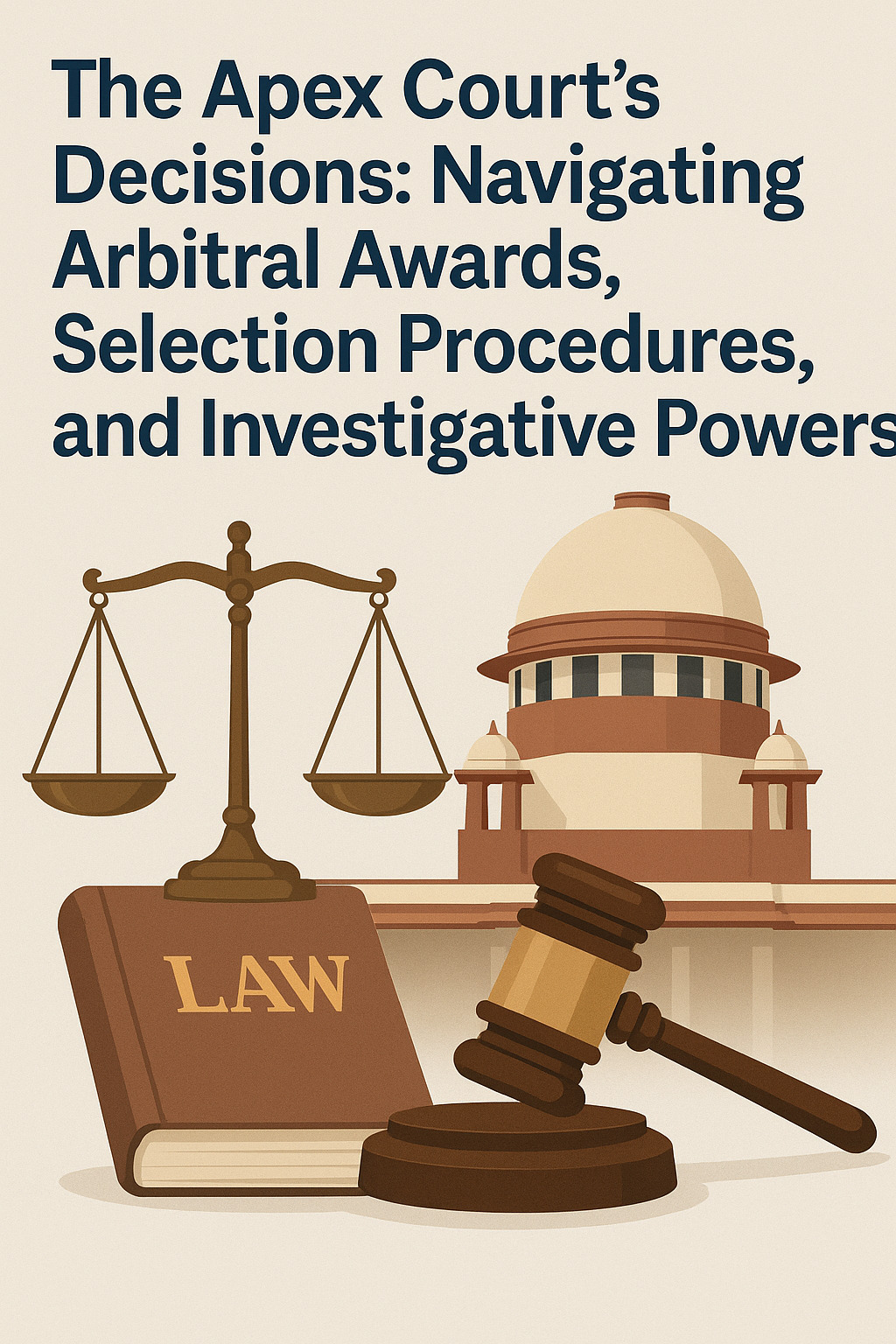View News
The-Apex-Court-Decisions-Navigating-Arbitral-Awards-Selection-Procedures-and-Investigative-Powers

The Apex Court's Decisions: Navigating Arbitral Awards, Selection Procedures, and Investigative Powers
~Sura Anjana Srimayi
INTRODUCTION
India's Supreme Court, being the final court of law for disputing legal cases and the protector of the Constitution, is always in the driver's seat when it comes to determining the legal environment of the country. In the recent past, the top court has been seized with vital issues cutting across various fields of law, such as the enforcement and interpretation of arbitral awards, fairness and transparency in selection processes for public employment, and the controversial issue of the authority of a police officer to independently get specimen signatures and handwritings of an accused person during investigations. These decisions have far-reaching implications for commercial litigation, meritocracy and equality principles, and the fine balance between the rights of the accused and the requirements of effective criminal investigation.
SUPREME COURTS RULINGS
I. Decoding Arbitral Awards: Ensuring Finality and Navigating Challenges
Arbitration has become the favoured vehicle for settling commercial disagreements, providing an faster and often better specialist solution compared to ordinary litigation. The finality and enforcement of arbitral awards is generally the scope within which the role of the Supreme Court falls within this domain, together with maintaining a process that can see a legitimate challenge to the arbitral award.
A. Narrower Role for Courts: An overriding tenet sustaining arbitration is reduced judicial intrusion.
The Supreme Court has repeatedly reaffirmed this position, stressing that courts must not function as appellate bodies over arbitral tribunals. Unless an award is clearly vitiated by reasons like fraud, corruption, breach of natural justice, or patent illegality manifesting on the face of the award, courts are generally averse to interfering with the merits of the award. This method supports the independence of the arbitral process and facilitates the effectiveness of arbitration as a method of dispute resolution.
B. Grounds for Challenge Under the Arbitration and Conciliation Act, 1996: The Arbitration and Conciliation Act, 1996, as it is amended, enunciates certain grounds upon which an arbitral award can be challenged under Section 34. The Supreme Court has had a significant role in interpreting these grounds, clarifying their extent and ambit.
For example, the doctrine of "patent illegality manifesting on the face of the award" has come under judicial examination, the court making it clear that this does not embrace errors of fact or law except to the extent they reach to the root of the matter or contravene basic principles of Indian law.
C. Enforcement of Foreign Awards: The Supreme Court has also played an important role in simplifying enforcement of foreign arbitral awards under Section 47 to 49 of the Arbitration and Conciliation Act. Following the dicta of international comity, the court will typically exercise pro-enforcement inclination and only step in where the award meets the narrowly circumscribed exceptions, i.e., against public policy of India. This strategy further makes India a welcome jurisdiction for international commercial arbitration.
D. Current Decisions and Their Effect: New Supreme Court decisions in arbitration cases have tended to concentrate on refining the meaning of the challenge reasons and upholding the doctrine of limited judicial interference. For instance, the court has differentiated between an error within the arbitrator's jurisdiction and a jurisdictional error, noting that the former is normally not a ground for setting aside an award. These decisions bring more certainty to parties engaging in arbitration and make the process of dispute resolution more predictable and efficient.
II. Examining Selection Procedures: Maintaining Fairness and Meritocracy
The fairness and integrity of selection procedures for public employment are critical to the guarantee of a fair and equitable society. The Supreme Court, as the protector of constitutional rights, often steps in where charges of arbitrariness, bias, or violation of constitutional principles are brought in connection with such processes.
A. Principles of Equality and Non-Discrimination: Articles 14 and 16 of the Constitution assure equality before law and equality of opportunity in the sphere of public employment. The Supreme Court has uniformly maintained these principles, declaring selection processes which are found to be discriminatory or violative of the right of equality. This involves the assurance that criteria of selection are reasonable, objective, and non-discriminatory.
B. Transparency and Objectivity in Evaluation: The Supreme Court has stressed the importance of transparency and objectivity in candidate evaluation. This involves the clear articulation of selection criteria, ensuring fair and consistent application of these criteria, and giving reasons for decisions, especially where subjective judgments are made. Any departure from laid-down rules or the use of arbitrary procedures can be open to judicial review.
C. Addressing Allegations of Bias and Favoritism: The Supreme Court has been forthright against charges of partiality and favoritism in the selection process. Where compelling evidence of such malpractices is available, the court has refused to hesitate, even to the point of dismissing the entire selection process in order to promote fairness and meritocracy. This speaks volumes of the court's resolve to ensure that public hiring is on the basis of merit rather than on irrelevant considerations.
D. Judicial Review of Expert Opinions: In technical expertise-based selection processes, the Supreme Court usually gives due weight to expert body or selection committee opinions. The deference is never absolute. If the court determines that the recommendations of the expert body are patently arbitrary, unreasonable, or against accepted rules, it still has the power to interfere. The function of the court is to see to it that the procedure followed by the specialist body is just and in line with law, even as it gives deference to their specialist expertise.
E. Recent Rulings and Their Effect: Recent Supreme Court rulings in selection process cases have often revolved around issues such as the interpretation of eligibility criteria, the validity of changes made to the selection process midstream, and the justification for awarding weightage to certain qualifications or experience. The decisions of the court are intended to find a balance between the freedom of the recruitment agencies and ensuring the protection of the fundamental rights of the applicants, so that the choices are made on the basis of merit and in a transparent and unbiased manner.
III. The Possibility of a Police Officer Seeking Specimen Handwritings and Signatures Independently
Finding a Balance between Investigative Powers and the Rights of Accused Whether or not a police officer may procured specimen handwritings and signatures of an accused individual independently at the investigation stage without express consent or a judicial warrant is a touchy subject of balancing the exercise of powers of the police with the basic constitutional rights of an accused, of which a key one is the right against self-incrimination.
A. The Right Against Self-Incrimination (Article 20(3)): Article 20(3) of the Constitution assures that no individual charged with any offence shall be forced to be his/her own witness. The meaning of this basic right has been the focus of controversy for the collection of specimen signatures and handwriting during investigation. The question revolving around this is whether the furnishing of such samples amounts to compelled self-incrimination.
B. Conflicting Interpretations and Legal Precedents: In the past, there have been different views taken by different High Courts and even within the Supreme Court itself on this point. Certain decisions have laid down the proposition that providing specimen signatures or handwritings is simply a physical act and does not fall within the scope of "testimony" or "witness against oneself." Such decisions tend to base their reasoning on the fact that the accused is not being forced to reveal any knowledge or information, but rather giving a physical sample for comparison.
Nonetheless, other scholars have contended that forcing the accused to offer such samples, particularly in the absence of a court order, may be perceived as a violation of their right against self-incrimination if the samples are used directly to connect them with the crime. The risk of coercion and psychological pressure on the accused during inquiry are also factors raised by this school of argument.
C. Section 73 of the Evidence Act, 1872: Section 73 of the Indian Evidence Act gives power to the court to order any person who is in court to write any words or figures for the purpose of allowing the court to compare the writing so written with any writing which is said to have been written by such person.
This provision clearly gives the power to the court to procure specimen writings. The argument is over whether this power may be exercised by the police unilaterally during investigation without court intervention.
D. The Need for Clarity and Uniformity: The absence of a clear and consistent legal stance on this point has generated uncertainty for both law enforcement agencies and for the accused. This uncertainty may generate inconsistent practice at investigation level and possible challenges to the admissibility of such evidence in court. It is imperative that the Supreme Court intervenes to bring much-needed clarity and set a uniform legal framework on this delicate point.
E. Possible Ramifications of Supreme Court Decisions: Recent discussions and possible adjudications by the Supreme Court on this matter could have serious impacts on criminal investigations. If the court decides that police officers could not independently get specimen signatures and handwritings without a consent or judicial warrant, it would call for a modification of investigation procedures. Police authorities may have to approach the judiciary more often for such samples, possibly introducing a layer of procedural scrutiny.
On the other hand, if the court affirms the independent power of the police, it could facilitate investigations but might also be worried about the risk of abuse of power and violation of the rights of the accused.
The judgment will presumably seek to find a balance between the necessity for effective investigation and safeguarding basic rights.
CONCLUSION
The active intervention of the Supreme Court in issues relating to arbitral awards, selection procedures, and powers of investigation emphasizes its crucial role in shaping the contours of justice in India. In arbitration as well, the court's principle of minimal judicial intervention ensures efficacy and finality in commercial adjudication. By questioning selection methods, the court remains firm on its commitment to principles of equal justice, impartiality, and meritocracy of public employment. The current debate on the autonomous power of policemen to procure specimen signatures and handwriting serves to emphasize the court's important role in reconciling the imperatives of effective criminal investigation with the inherent rights of the accused. The judgments of the highest court in these varied but related fields of law will continue to leave an indelible mark on the legal environment, shaping commercial transactions, canons of governance, and criminal justice administration in India.
The country looks forward to these decisions, hoping for greater clarity, consistency, and a reassertion of the foundational principles that govern the Indian legal system.
Unlock the Potential of Legal Expertise with LegalMantra.net - Your Trusted Legal Consultancy Partner”
Disclaimer: Every effort has been made to avoid errors or omissions in this material in spite of this, errors may creep in. Any mistake, error or discrepancy noted may be brought to our notice which shall be taken care of in the next edition In no event the author shall be liable for any direct indirect, special or incidental damage resulting from or arising out of or in connection with the use of this information Many sources have been considered including Newspapers, Journals, Bare Acts, Case Materials , Charted Secretary, Research Papers etc.

